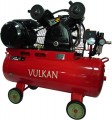Receiver volume
The receiver is a tank (cylinder) into which compressed air is pumped during operation of the compressor; it is from this cylinder (and not directly from the working mechanism) that it is fed to the connected instrument. The main meaning of such a scheme is that the receiver compensates for pressure unevenness that occurs during the operation of the main mechanism; it does not guarantee absolute constancy, however, all changes occur very smoothly. In addition, energy savings are ensured in this way: part of the time the compressor runs on the stored air from the receiver, and the engine turns on only when the pressure in the tank is significantly reduced to replenish supplies. Therefore, this piece of equipment is practically mandatory, models
without a receiver are extremely rare today.
In general, the larger the volume of the receiver, the less often it will have to be pumped up after the initial filling with compressed air. It is also believed that a volumetric receiver can partly compensate for the lack of compressor performance; however, this moment does not ensure the constant stable operation of the “gluttonous” tool and serves only as a fallback in case of a short-term increase in air consumption. On the other hand, large volumes mean the corresponding dimensions of the tank (and it is already the largest part in most compressors), and the cost of the device increases accordingly. Therefore, when choosing, it is worth observi
...ng a certain balance and choosing a receiver depending on the specifics of the work. For various types of activities there are recommendations, they can be found in special sources. Here we note that for relatively uniform work in time with a small air flow, a small receiver is usually enough, and if peak loads can occur frequently, it is better to choose a larger cylinder.
Some compressors may provide the expansion of the receiver with additional tanks.Design features
—
Frequency converter. This function is used to automatically control the power of the motor in the compressor (see "Motor type"), more precisely, to adjust the speed to the current air consumption and maintain a constant pressure.
In electrical units, in addition to reducing wear and tear and eliminating current surges in the network, such systems provide the most stable air pressure at the outlet, and energy is spent more rationally. At the same time, frequency converters are expensive and take up quite a lot of space; and the advantages mentioned are relevant for heavy professional-grade equipment. Therefore, this function is found mainly among industrial compressors with an operating voltage of 400 V and based on internal combustion engines.
—
Dehumidifier. The purpose of such devices is already clear from the name: they are designed to dry the air at the compressor inlet, that is, to remove excess moisture from it. The need for such a procedure is primarily due to the fact that high humidity adversely affects the state of the compressor: it leads to condensate settling, and it, in turn, contributes to corrosion and the formation of various emulsions, due to which the channels become dirty and the wear of the entire unit increases .
—
Tandem. Devices created according to the "tandem" scheme are actually two compressors on one receiver, connected
...in parallel. This allows you to turn on both compressors at once, or only one of them — in this way you can adjust the power and performance even in those models where special regulators such as a frequency converter (see the relevant paragraph) are not provided at all.
Among the disadvantages are heavy weight, bulkiness and high cost. In addition, the tandem operation scheme is mainly suitable for powerful performant units — otherwise the individual compressors would have to be made too small, and this does not make sense.
— Wheels for transportation. The presence of special transport wheels in the design of the compressor. Modern compressors can be of considerable weight, which would require the participation of several people when carried; wheels, on the other hand, allow you to move even rather weighty devices without problems by the forces of one, in extreme cases — two people.Noise level
The maximum noise level produced by the compressor during operation. When evaluating it, it must be taken into account that the decibel used to evaluate noise is not an absolute value. In fact, this means that noises, for example, 20 dB and 40 dB differ in level not by a factor of 2, but by 100 — it is this multiplicity that corresponds to a difference of 20 dB; a twofold increase corresponds to a 3 dB increase. Therefore, to assess noise levels, it is worth referring primarily to comparative tables. For values found in modern compressors, this table would look something like this:
70 dB — loud conversations at a distance of about 1 m;
75 dB — scream;
80 dB — motorcycle engine with silencer;
85 dB — loud scream;
90 dB — freight train car at a distance of 5-7 m;
95 dB — noise inside the subway car.
Anyway, the lower the level of noise produced by the unit, the more comfortable its use, the less it will “hit on the ears” and increase the volume of the entire set of working instruments.

